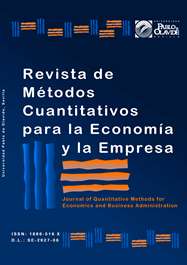Empaquetamiento e incentivos para mejoras en calidad
DOI:
https://doi.org/10.46661/revmetodoscuanteconempresa.3624Palabras clave:
empaquetamiento, mejoras en calidad, telecomunicaciones, regulaciónResumen
Este estudio presenta la competencia más allá de un solo mercado producto donde una firma multiproducto compite con rivales monoproducto mediante el uso de diferentes estrategias de empaquetamiento que impactan los incentivos de las firmas por realizar mejoras de calidad en diferentes modos. La estrategia de empaquetamiento puro puede hacer que la firma multiproducto invierta en mejoras de calidad cuando los costos asociados son comparativamente bajos y la utilidad adicional de la mejora de calidad es relativamente alta, pero desalienta a las firmas monoproducto a mejorar la calidad. En el caso de empaquetamiento mixto, este resultado inevitablemente sucede en el mercado más competitivo y probablemente se encuentra en el mercado menos competitivo cuando los mercados no son tan diferentes en intensidad competitiva. Por lo tanto, ambas estrategias de empaquetamiento afectan el excedente del consumidor cuando los dos mercados son significativamente diferentes en la intensidad de la competencia debido a la influencia negativa de las distorsiones del mercado después de interrelacionar los dos mercados.
Descargas
Citas
Armstrong, M. (2011). Bundling revisited:substitute products and inter-firm discounts. Economics Series Working Papers 574, University of Oxford.
Avenali, A., D’Annunzio, A., & Reverberi, P. (2013). Bundling, competition and quality investment: a welfare analysis. Review of Industrial Organization, 43(3), 221-241.
Choi, J.P. (1996). Preemptive R&D, rent dissipation, and the “Leverage Theory”. Quarterly Journal of Economics, 111(4), 1153-1181.
Choi, J.P. (2004). Tying and innovation: A dynamic analysis of tying arrangements. Economic Journal, 114(492), 83-101.
Gans, J.S., & King, S.P. (2006). Paying for loyalty: product bundling in oligopoly. Journal of Industrial Economics, 54(1), 43-64.
Granier, L., & Podesta, M. (2010). Bundling and mergers in energy markets. Energy Economics, 32(6), 1316-1324.
Heeb, R. (2003). Innovation and vertical integration in complementary markets. Journal of Economics and Management Strategy, 12(3), 387-417.
Krämer, J. (2009). Bundling vertically differentiated communications services to leverage market power. Journal of policy, regulation and strategy for telecom-munications, 11(3), 64-74.
Matutes, C., & Regibeau, P. (1992). Compatibility and bundling of complementary goods in a duopoly. Journal of Industrial Economics, 40(1), 37-54.
Nalebuff, B. (2004). Bundling as an entry barrier. Quarterly Journal of Economics, 119(1), 159-187.
Reisinger, M. (2006). Product bundling and the correlation of valuations in duopoly. Discussion papers in economics, University of Munich.
Rennhoff, A.D., & Serfes, K. (2009). The role of upstream-downstream competition on bundling decisions: should regulators force firms to unbundle? Journal of Economics & Management Strategy, 18(2), 547-588.
Thanassoulis, J. (2007). Competitive mixed bundling and consumer surplus. Journal of Economics & Management Strategy, 16(2), 437-467.
Thanassoulis, J. (2011). Is multimedia convergence to be welcomed? Journal of Industrial Economics, 59(2), 225-253.
Tirole, J. (1988). The theory of industrial organization. MIT press.
Venkatesh, R., & Kamakura, W. (2003). Optimal bundling and pricing under a monopoly: Contrasting complements and substitutes from independently valued products. Journal of Business, 76(2), 211-231.
Wauthy, X. (1996). Quality choice in models of vertical differentiation. Journal of Industrial Economics, 44(3), 345-353.
Publicado
Cómo citar
Número
Sección
Licencia
Derechos de autor 2020 Revista de Métodos Cuantitativos para la Economía y la Empresa

Esta obra está bajo una licencia internacional Creative Commons Atribución-CompartirIgual 4.0.
El envío de un manuscrito a la Revista supone que el trabajo no ha sido publicado anteriormente (excepto en la forma de un abstract o como parte de una tesis), que no está bajo consideración para su publicación en ninguna otra revista o editorial y que, en caso de aceptación, los autores están conforme con la transferencia automática del copyright a la Revista para su publicación y difusión. Los autores retendrán los derechos de autor para usar y compartir su artículo con un uso personal, institucional o con fines docentes; igualmente retiene los derechos de patente, de marca registrada (en caso de que sean aplicables) o derechos morales de autor (incluyendo los datos de investigación).
Los artículos publicados en la Revista están sujetos a la licencia Creative Commons CC-BY-SA de tipo Reconocimiento-CompartirIgual. Se permite el uso comercial de la obra, reconociendo su autoría, y de las posibles obras derivadas, la distribución de las cuales se debe hacer con una licencia igual a la que regula la obra original.
Hasta el volumen 21 se ha estado empleando la versión de licencia CC-BY-SA 3.0 ES y se ha comenzado a usar la versión CC-BY-SA 4.0 desde el volumen 22.










